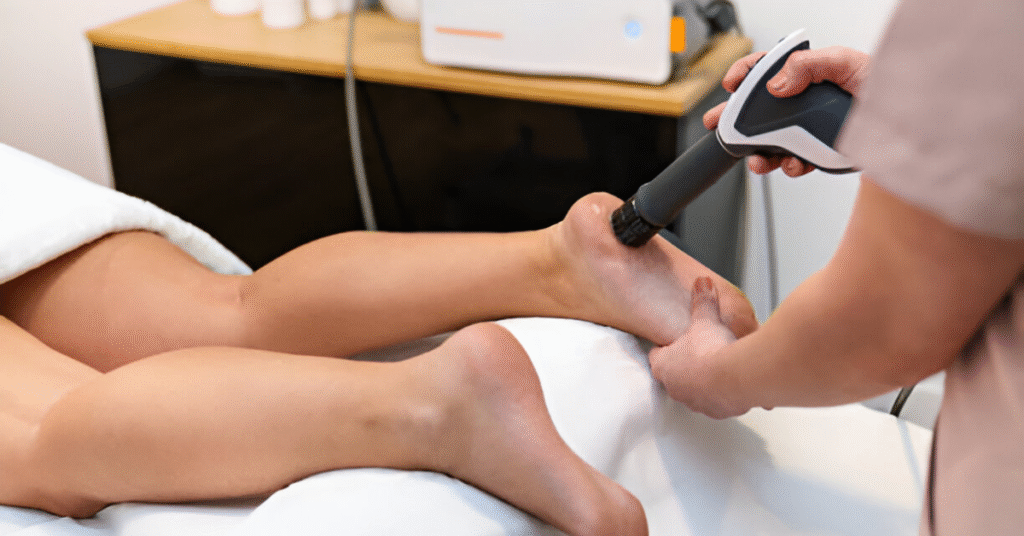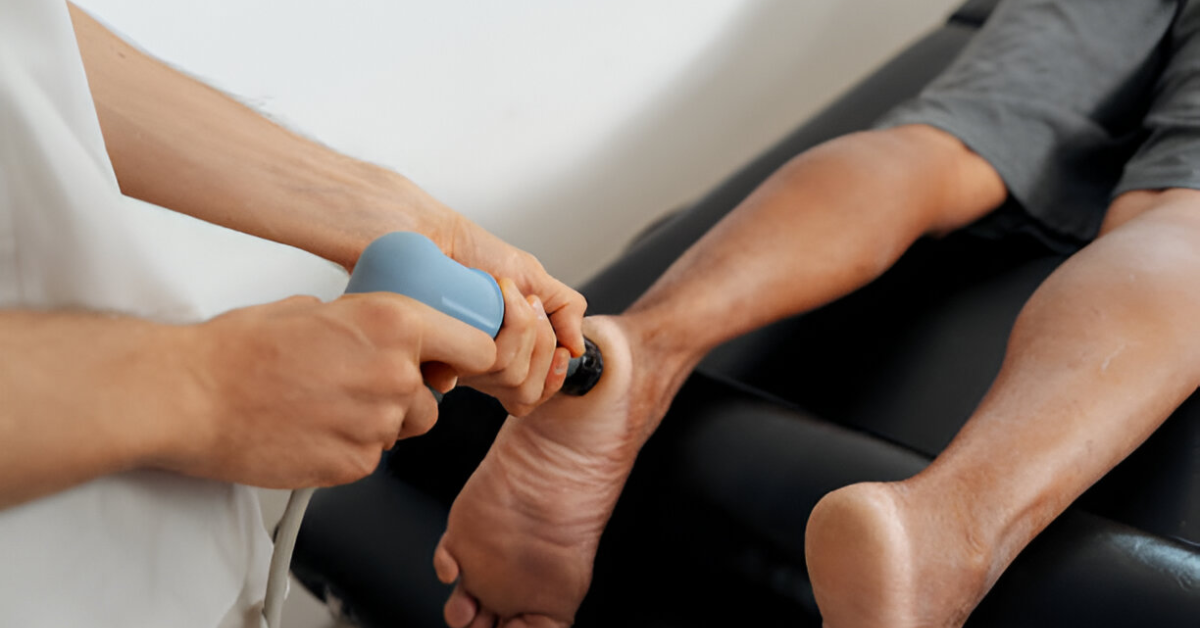Introduction
If you’ve been struggling with chronic foot or heel pain that just won’t go away, you might have heard about extracorporeal shockwave therapy (ESWT) as a treatment option. This non-surgical approach has been gaining attention among patients and healthcare professionals alike. Originally used to break down kidney stones, ESWT has now become a proven therapy for many musculoskeletal disorders; especially conditions affecting the feet and ankles.
At Sole Foot and Ankle in Valparaiso, we’ve seen firsthand how extracorporeal shock wave treatment can help patients reduce pain, restore mobility, and get back to an active lifestyle. In this guide, we’ll break down how ESWT works, what conditions it helps, and what you can expect if you choose this therapy.
What Is Extracorporeal Shockwave Therapy (ESWT)?
Extracorporeal shockwave therapy (ESWT) uses high-energy sound waves; also called pressure waves; to stimulate healing in injured tissues. These waves are delivered through the skin directly to the affected area.
There are two main types of ESWT:
- Focused ESWT: Delivers precise shockwaves deep into tissues to target specific injuries.
- Radial shockwaves (Radial Pressure Waves): Spread over a broader area and are often used for more surface-level issues.
Both types of shockwave therapy ESWT are safe, effective, and non-invasive. The treatment is performed in-office and usually takes less than 30 minutes.
Conditions ESWT Can Treat
At our clinic, extracorporeal shock wave treatment is most often used for foot and ankle conditions, but it’s also effective for other musculoskeletal disorders. Some of the most common conditions include:
- Plantar fasciitis (chronic heel pain)
- Achilles tendonitis
- Heel spurs
- Stress-related shin pain
- Tennis elbow (outside the foot/ankle, but still treatable with ESWT)
- Patellar tendonitis (jumper’s knee)
Because ESWT promotes healing and increases blood flow, it’s especially helpful for injuries that haven’t responded well to traditional treatments like rest, ice, physical therapy, or orthotics.
How Does Extracorporeal Shockwave Therapy (ESWT) Work?
The concept may sound high-tech, but the science behind extracorporeal shockwave therapy ESWT is straightforward:
- Shockwaves penetrate the tissue. These are mechanical sound waves, not electrical shocks.
- Cell regeneration is stimulated. Shockwaves encourage the body to create new blood vessels, improve circulation, and activate healing cells.
- Scar tissue breaks down. The waves help soften and remodel damaged tissues.
- Pain is reduced. ESWT interrupts nerve signaling that causes chronic pain, while promoting long-term recovery.
Over time, this process reduces pain and improves function without the need for surgery or extended downtime.

Benefits of Extracorporeal ShockWave Treatment
- Non-invasive: No needles, no incisions, no downtime.
- Promotes healing: Instead of masking pain, ESWT encourages the body to repair itself.
- Quick treatments: Sessions usually last 20–30 minutes.
- Proven results: Many patients feel relief after just a few treatments.
- Alternative to surgery: Helps patients avoid invasive procedures in many cases.
What to Expect During Treatment
When you visit Sole Foot and Ankle for shockwave therapy ESWT, here’s what usually happens:
- Evaluation: Your podiatrist will examine your condition and confirm if ESWT is appropriate.
- Preparation: A gel is applied to the treatment area to help conduct the shockwaves.
- Treatment: The handheld device is placed against your skin and sends pressure waves into the targeted area.
- Recovery: You may feel mild soreness (like after a workout), but most patients resume normal activities right away.
How Many Sessions Are Needed?
Most patients need 3–5 sessions spaced about a week apart. Some notice improvement after the first session, while others may take a few weeks to feel the full effect.
Are There Risks or Side Effects?
Extracorporeal shock wave treatment is considered safe, but like any medical therapy, there can be side effects. These are typically mild and temporary:
- Redness or swelling in the treated area
- Bruising
- Mild discomfort during or after treatment
Serious side effects are rare, and your podiatrist will review your medical history to make sure ESWT is right for you.
Patient Testimonials
“I’d been dealing with plantar fasciitis for over a year and nothing seemed to help. After three sessions of ESWT at Sole Foot and Ankle, I can finally walk without stabbing heel pain. It feels like I have my life back.” – Local patient in Valparaiso
“I was nervous at first, but the treatment was quick and the results have been amazing. My Achilles tendon pain is gone after years of struggling.” – Runner treated at Sole Foot and Ankle
Frequently Asked Questions About ESWT
1. Is extracorporeal shockwave therapy ESWT painful?
Most patients describe it as mildly uncomfortable, like a tapping or pulsing sensation, but not unbearable.
2. How long does it take for ESWT to work?
Some patients feel relief after the first session, but lasting improvement usually develops after several treatments over a few weeks.
3. Do I need to rest after ESWT?
You can typically return to normal daily activities right away, but avoid intense exercise for 24–48 hours.
4. How long do the results last?
For many, the effects are long-lasting because ESWT treats the root cause, not just the symptoms.
5. Who should not have ESWT?
Patients with blood clotting disorders, active infections, or who are pregnant should avoid this treatment. Your podiatrist will guide you.
The Future of Shockwave Therapy
Research continues to explore new uses for shockwave therapy ESWT beyond foot and ankle care. From sports injuries to joint pain, the ability of shockwaves to promote healing and reduce pain is opening doors for broader treatment applications.
A Note from Sole Foot and Ankle
At Sole Foot and Ankle Valparaiso, we’re proud to offer advanced treatments like extracorporeal shockwave therapy (ESWT) to help our patients live pain-free. If you’re struggling with chronic heel pain, plantar fasciitis, Achilles tendonitis, or another foot condition, ESWT may be the solution you’ve been waiting for.
Don’t let foot pain hold you back. Schedule an appointment with our experienced Valparaiso podiatrists today and find out if extracorporeal shock wave treatment is right for you.
Call us or book your appointment online today.



